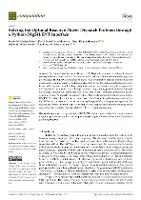Resumen
The Optimal Reactive Power Dispatch (ORPD) problem consists of finding the optimal settings of reactive power resources within a network, usually with the aim of minimizing active power losses. The ORPD is a nonlinear and nonconvex optimization problem that involves both discrete and continuous variables; the former include transformer tap positions and settings of reactor banks, while the latter include voltage magnitude settings in generation buses. In this paper, the ORPD problem is modeled as a mixed integer nonlinear programming problem and solved through two different metaheuristic techniques, namely the Mean Variance Mapping Optimization and the genetic algorithm. As a novelty, the solution of the ORPD problem is implemented through a PythonDIgSILENT interface that combines the strengths of both software. Several tests were performed on the IEEE 6-, 14-, and 39-bus test systems evidencing the applicability of the proposed approach. The results were contrasted with those previously reported in the specialized literature, matching, and in some cases improving, the reported solutions with lower computational times.














